air blower pressure relief valve
Understanding Air Blower Pressure Relief Valves An Essential Component for Safety and Efficiency
Air blower systems are ubiquitous in various industrial applications, where maintaining optimal pressure and airflow is crucial. One of the vital components that ensure these systems operate safely and efficiently is the air blower pressure relief valve. This article delves into the significance of these valves, how they function, and the reasons why they are indispensable in air blower systems.
The Function of Pressure Relief Valves
A pressure relief valve is a safety device designed to prevent excess pressure from building up in a system, which could lead to catastrophic failures. In the context of air blowers, when the system pressure exceeds a predetermined level, the pressure relief valve opens to allow excess air to escape. This action not only mitigates the risk of damage to the blower itself but also protects connected equipment and ensures safe operational conditions.
Importance of Maintaining Optimal Pressure
Maintaining the correct pressure in air blower systems is crucial for several reasons. Firstly, it ensures that the air blower operates within its design parameters, which is essential for efficient performance. Operating at improper pressures can lead to higher energy consumption, increased wear and tear, and reduced lifespan of the equipment. Secondly, excessive pressure can cause leaks or ruptures in ductwork, resulting in a loss of efficiency and potential safety hazards.
Types of Pressure Relief Valves
air blower pressure relief valve

Pressure relief valves come in various designs, adaptable to specific applications. The most common types include spring-loaded valves, which are designed to open when the pressure exceeds the set limit, and pilot-operated valves, which utilize a smaller valve to control a larger valve's operation. Additionally, there are balanced bellows valves that are designed to diminish the effects of back pressure and provide a more accurate operation.
Selecting the appropriate type of pressure relief valve is crucial to ensure the system's security and efficiency. Factors such as the expected pressure range, the nature of the air being moved, and environmental conditions must be considered.
Maintenance and Inspection
Regular maintenance and inspection of pressure relief valves are essential to ensure their reliability. Accumulated dirt or corrosion can hinder a valve's operation, causing it to malfunction during critical moments. Routine checks should involve testing the valve for leaks, verifying that it opens at the correct pressure, and ensuring there are no blockages in the discharge path. Keeping these valves in optimal condition not only adheres to safety standards but also helps in maintaining the overall performance of the blower system.
Conclusion
Air blower pressure relief valves are crucial components that protect both equipment and personnel in various industrial settings. By preventing excessive pressure from causing system failures, these valves play a vital role in maintaining operational efficiency and safety. Investing in high-quality pressure relief valves and committing to regular maintenance and inspections can ensure the longevity of air blower systems and foster a safer working environment. In a world where efficiency and safety are paramount, understanding and implementing effective pressure management through these valves is a step towards achieving both. Therefore, industries should prioritize the integration of reliable pressure relief valves in their air blower systems to ensure their operational success.
-
The Smarter Choice for Pedestrian AreasNewsJun.30,2025
-
The Gold Standard in Round Drain CoversNewsJun.30,2025
-
The Gold Standard in Manhole Cover SystemsNewsJun.30,2025
-
Superior Drainage Solutions with Premium Gully GratesNewsJun.30,2025
-
Superior Drainage Solutions for Global InfrastructureNewsJun.30,2025
-
Square Manhole Solutions for Modern InfrastructureNewsJun.30,2025
-
Premium Manhole Covers for Modern InfrastructureNewsJun.30,2025
